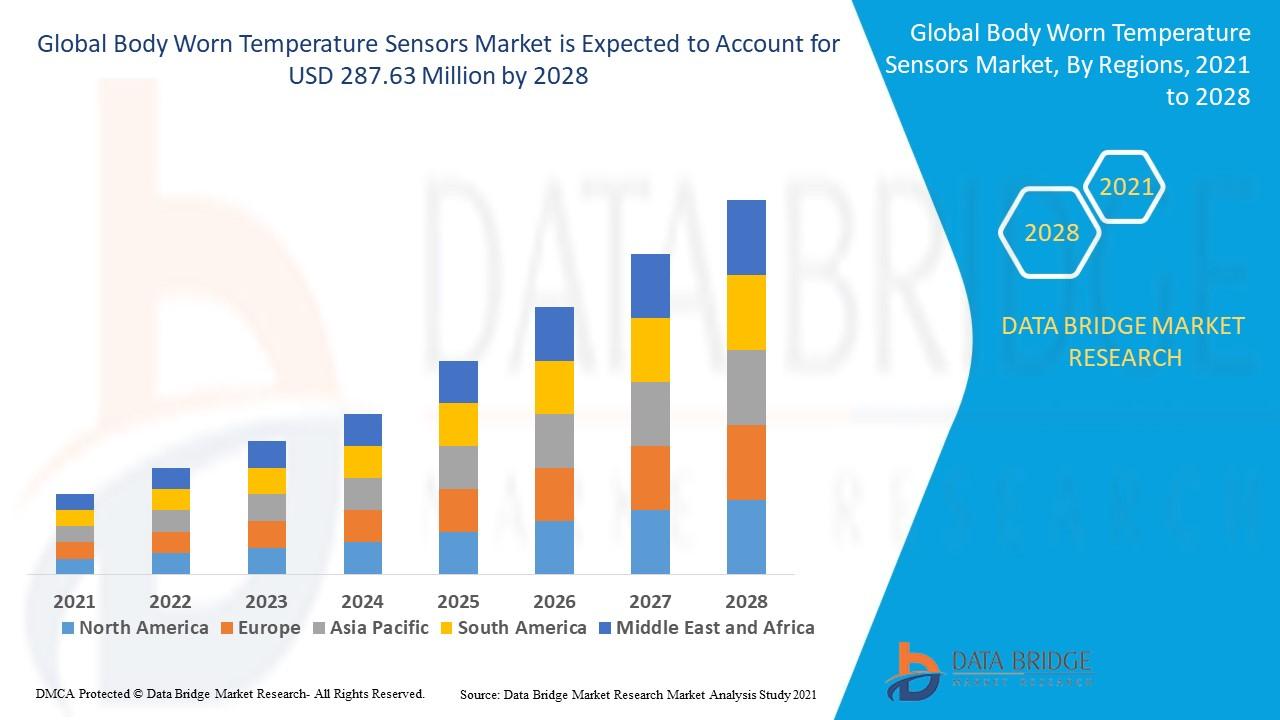Executive Summary Body Worn Temperature Sensors Market :
The body worn temperature sensors market is expected to witness market growth at a rate of 40.25% in the forecast period of 2021 to 2028 and is expected to reach by the value of USD 287.63 million by 2028.
The Body Worn Temperature Sensors Market report highlights the global key manufacturers to define, describe and analyze the market competition landscape. With the complete comprehension of business goals and needs to bridge the gap, this Body Worn Temperature Sensors Market report is generated which delivers the most suitable solutions. This market research report delivers the systematic and comprehensive market research study, along with the facts and figures associated with any subject in the field of marketing. This effective and insightful report assists clients to stay ahead of the time and competition. In this global Body Worn Temperature Sensors Market report, all the company profiles of the major players and brands are covered extensively.
This Body Worn Temperature Sensors Market research report identifies, estimates, and analyses the emerging trends along with major drivers, restraints, challenges and opportunities in the market. The competitive analysis of the major market players studied in the report, assists businesses take better moves for improving their product and sales. This professional and detailed report focuses on primary and secondary drivers, market share, market size, leading segments and geographical analysis. In addition, Body Worn Temperature Sensors Market research report forecasts the size of the market with information on key vendor revenues, development of the industry by upstream & downstream, industry progress, key companies, along with type segment & market application.
Discover the latest trends, growth opportunities, and strategic insights in our comprehensive Body Worn Temperature Sensors Market report. Download Full Report: https://www.databridgemarketresearch.com/reports/global-body-worn-temperature-sensors-market
Body Worn Temperature Sensors Market Overview
**Segments**
- **By Type**: Contact Sensors, Non-contact Sensors
- **By Application**: Healthcare, Fitness and Wellness, Military and ense, Others
- **By End-User**: Hospitals and Clinics, Homecare Settings, Fitness and Sports Centers, Military and ense
The global body worn temperature sensors market is segmented based on type, application, and end-user. The types of body worn temperature sensors included in the market are contact sensors and non-contact sensors. Contact sensors are those that require physical contact with the skin to measure temperature accurately, while non-contact sensors can measure body temperature from a distance without direct contact. In terms of applications, the market caters to various sectors such as healthcare, fitness and wellness, military and ense, and others. The end-users of body worn temperature sensors include hospitals and clinics, homecare settings, fitness and sports centers, as well as military and ense establishments.
**Market Players**
- Medtronic
- Koninklijke Philips N.V.
- Hill-Rom Services Inc.
- OMRON Corporation
- LifeSignals Group Inc.
- VitalConnect
- Sensirion AG
- Abbott
- Texas Instruments Incorporated
- Maxim Integrated
- Analog Devices, Inc.
- Siemens Healthcare GmbH
Key players in the global body worn temperature sensors market include Medtronic, Koninklijke Philips N.V., Hill-Rom Services Inc., OMRON Corporation, LifeSignals Group Inc., VitalConnect, Sensirion AG, Abbott, Texas Instruments Incorporated, Maxim Integrated, Analog Devices, Inc., and Siemens Healthcare GmbH. These market players are focused on product innovation, strategic partnerships, and geographical expansion to strengthen their market position and meet the increasing demand for body worn temperature sensors worldwide.
The global body worn temperature sensors market is witnessing significant growth driven by technological advancements, the rising prevalence of chronic diseases, and increasing awareness about health monitoring. Contact sensors, although traditional, are reliable in providing accurate temperature readings by coming into direct contact with the skin. On the other hand, non-contact sensors are becoming increasingly popular due to their convenience and hygiene factors, especially in healthcare settings where minimizing physical contact is crucial to prevent infections. The versatility of body worn temperature sensors across various applications is expanding their market reach beyond healthcare to include fitness and wellness, military and ense, and other sectors like industrial workplaces where monitoring body temperature is essential for ensuring employee safety and well-being.
Key players in the market are constantly investing in research and development activities to introduce advanced features in body worn temperature sensors. These innovations include enhanced accuracy, real-time monitoring capabilities, seamless connectivity with smartphones or other devices, and long-term durability to withstand different environmental conditions. Strategic partnerships and collaborations with healthcare providers, technology companies, and research institutions are also common strategies adopted by market players to leverage expertise and resources for developing cutting-edge solutions that cater to the evolving needs of end-users.
The adoption of body worn temperature sensors in hospitals and clinics is increasing rapidly, as healthcare professionals recognize the importance of continuous monitoring of patients' body temperature for early detection of infections or other health issues. Homecare settings are also witnessing a surge in the use of these sensors, driven by the growing trend towards remote patient monitoring and self-management of chronic conditions. Furthermore, fitness and sports centers are incorporating body worn temperature sensors into their programs to track athletes' performance, prevent overheating during intense workouts, and optimize training regimens for better results.
In the military and ense sector, body worn temperature sensors play a crucial role in monitoring soldiers' health and well-being in challenging environments. These sensors help in detecting early signs of heat exhaustion, dehydration, or other temperature-related issues, enabling timely intervention and ensuring operational readiness. The integration of advanced technologies like artificial intelligence, Internet of Things (IoT), and data analytics is further enhancing the capabilities of body worn temperature sensors to deliver actionable insights and personalized recommendations for users across different end-user segments.
Overall, the global body worn temperature sensors market is poised for continued growth driven by the increasing emphasis on preventive healthcare, technological innovations, and the expanding applications of these sensors in diverse sectors. Collaborations, investments in research and development, and strategic market expansion will be key strategies for market players to stay competitive and capitalize on the growing demand for advanced body worn temperature sensing solutions worldwide.The global body worn temperature sensors market is experiencing substantial growth propelled by several key factors. Technological advancements in sensor design and functionality are driving the market forward, enabling more accurate and efficient temperature monitoring capabilities. The increasing prevalence of chronic diseases, coupled with a growing emphasis on proactive health monitoring, is fostering a greater demand for body worn temperature sensors. As individuals become more health-conscious and seek continuous monitoring solutions, the market is witnessing a surge in adoption across various sectors.
One of the pivotal trends shaping the market is the shift towards non-contact sensors, especially in healthcare settings. Non-contact sensors offer the advantage of measuring body temperature without direct physical contact, enhancing convenience and minimizing the risk of infection transmission. This is particularly crucial in environments like hospitals and clinics, where infection prevention protocols are paramount. As a result, non-contact sensors are gaining traction and are expected to drive market growth in the coming years.
Moreover, the versatility of body worn temperature sensors is expanding their applicability beyond traditional healthcare settings. The incorporation of these sensors in fitness and sports centers is enabling comprehensive monitoring of athletes' performance and well-being. By tracking body temperature fluctuations during workouts, these sensors help optimize training regimens and prevent overheating, thereby enhancing athletic performance and reducing the risk of injuries. This trend underscores the growing importance of real-time health monitoring in sports and fitness activities.
In the military and ense sector, body worn temperature sensors play a critical role in ensuring the health and safety of personnel operating in challenging environments. By detecting early signs of heat-related issues such as dehydration or heat exhaustion, these sensors support timely interventions and help maintain operational readiness. With advancements in sensor technology and the integration of cutting-edge features like artificial intelligence and IoT, body worn temperature sensors are becoming increasingly sophisticated, providing enhanced monitoring capabilities and actionable insights for users in diverse end-user segments.
Overall, the global body worn temperature sensors market is poised for continued growth driven by the convergence of technological innovation, increasing health awareness, and expanding applications across various industries. Market players need to focus on product development, strategic partnerships, and customer-centric solutions to meet the evolving needs of end-users. By investing in research and development, fostering collaborations with industry stakeholders, and expanding their market presence, companies can capitalize on the growing demand for advanced body worn temperature sensing solutions and maintain a competitive edge in the dynamic market landscape.
The Body Worn Temperature Sensors Market is highly fragmented, featuring intense competition among both global and regional players striving for market share. To explore how global trends are shaping the future of the top 10 companies in the keyword market.
Learn More Now: https://www.databridgemarketresearch.com/reports/global-body-worn-temperature-sensors-market/companies
DBMR Nucleus: Powering Insights, Strategy & Growth
DBMR Nucleus is a dynamic, AI-powered business intelligence platform designed to revolutionize the way organizations access and interpret market data. Developed by Data Bridge Market Research, Nucleus integrates cutting-edge analytics with intuitive dashboards to deliver real-time insights across industries. From tracking market trends and competitive landscapes to uncovering growth opportunities, the platform enables strategic decision-making backed by data-driven evidence. Whether you're a startup or an enterprise, DBMR Nucleus equips you with the tools to stay ahead of the curve and fuel long-term success.
The report provides insights on the following pointers:
- Market Penetration: Comprehensive information on the product portfolios of the top players in the Body Worn Temperature Sensors Market.
- Product Development/Innovation: Detailed insights on the upcoming technologies, R&D activities, and product launches in the market.
- Competitive Assessment:In-depth assessment of the market strategies, geographic and business segments of the leading players in the market.
- Market Development:Comprehensive information about emerging markets. This report analyzes the market for various segments across geographies.
- Market Diversification:Exhaustive information about new products, untapped geographies, recent developments, and investments in the Body Worn Temperature Sensors Market.
Browse More Reports:
Global Inhaled Nitric Oxide Market
Europe Contraceptive Devices Market
Global Breast Cancer Metastatic Market
Germany Foam Insulation Market
Middle East and Africa Biodegradable Film Market
North America Total Organic Carbon (TOC) Analyzer Market
Asia-Pacific Polyglycerol Market
Global Smart Bottle Market
Global Animal Based Shortenings Market
Global Specialty Crop Market
Global Spinal Cord Stimulators Market
Global Cookies Market
Global Clinical Reference Laboratory Market
Global Polypropylene Market
About Data Bridge Market Research:
An absolute way to forecast what the future holds is to comprehend the trend today!
Data Bridge Market Research set forth itself as an unconventional and neoteric market research and consulting firm with an unparalleled level of resilience and integrated approaches. We are determined to unearth the best market opportunities and foster efficient information for your business to thrive in the market. Data Bridge endeavors to provide appropriate solutions to the complex business challenges and initiates an effortless decision-making process. Data Bridge is an aftermath of sheer wisdom and experience which was formulated and framed in the year 2015 in Pune.
Contact Us:
Data Bridge Market Research
US: +1 614 591 3140
UK: +44 845 154 9652
APAC : +653 1251 975
Email:- corporatesales@databridgemarketresearch.com



